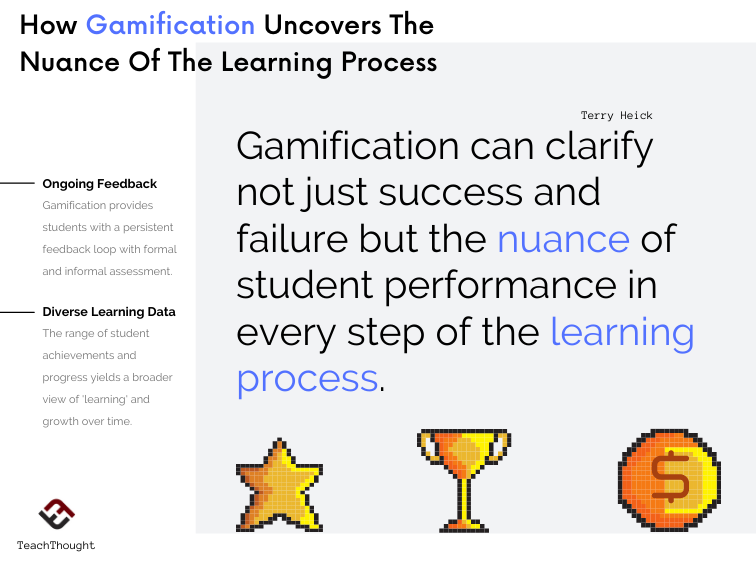The Role of Gamification in Modern Education
Gamification is used in many fields and industries. It is meant to promote customer loyalty in business: ” Find a discount among our 5 latest emails to get 50% off dedicated server hosting.”
It’s a little different in education. Gamification in education aims to provide a more interactive learning experience for students while providing evidence of their progress through rewards.
Gamification plays a key role in modern education and offers many benefits besides just making the learning process fun.
About Gamification
Gamification is the process of making various activities more entertaining by making them into games.
See also The Difference Between Game-Based Learning and Gamification
In education, gamification involves incorporating game elements (usually game design) into educational settings and learning materials to boost students’ enthusiasm for learning and skills such as analytical thinking, problem-solving, communication, and collaboration. Educational gamification doesn’t mean turning every lesson into a game but rather using game features to enrich lessons.
Games can help educators determine the strategy they need to apply to promote a certain skill or activity. For example, they can propose activities involving competition to promote social interaction or customization to encourage creativity.
In short, gamification is there to increase motivation and interest in learning.
See also How To Remove The Gamification From Your Classroom
Benefits of Gamification
The gamification benefits are hard to deny and very visible; thus, we mention the most substantial ones below.
Better Cognitive Development
Gamification is proven to activate the brain areas associated with cognitive development. Moreover, gamified learning accelerates brain activity and speeds up the development of various skills.
The diversity of ways the task is presented through gamification helps expand the range of situational analysis and problem-solving too.
Higher Engagement Levels
Increased engagement in a classroom is one of the most profound effects of gamification. Conventional learning methods often struggle to maintain the student’s attention and focus frequently leading to worse learning results.
Gamification uses challenges, leaderboards, points, badges, etc., to encourage exploration and curiosity and keep students engaged.
Making Learning Visible
One of the reasons why students aren’t as invested in the learning process as they could be is because it’s hard to define the learning journey without specific milestones and something that represents them.
Gamification helps make the learning process visible. Rewards or points are often acquired after completing a certain task, or there’s a physical result of collaboration to remind students of a certain activity.
Promoting Growth Mindset
Feeling ashamed or embarrassed is very real for students of various ages. There’s also a fear of failure that could potentially be witnessed by other classmates, which is translated into pressure.
Introducing game elements into the learning process creates an atmosphere of effortless self-expression. Plus, it makes failing fun and even something to bond over.
Like in a video game, where you fail but get to try again, this time knowing what you can expect, gamification introduces a perspective where failing is just a part of the process. This way, gamification helps build persistence and confidence.
How Effective is Gamification?
Gamification has many benefits, and thanks to them is very effective. Based on research and statistics, gamification leads to:
Almost 90% increase in student performance.
68% increase in motivation towards learning.
300% homework completion rate.
Faster task completion in more than 50% of cases.
Continuous study improvement for 73% of students with ADHD.
Students desire to be a part of improving the learning process.
How Gamification Can Help Different Students
Gamification can promote an equal environment for innately unique students.
The reality is that the classroom is diverse and students will find one task of different complexity. Gamified lessons can help students approach and complete tasks that seem too difficult or too easy in an enjoyable way, all the while helping learners stay on track with the curriculum.
Gamification can help:
-Break down difficult material. Gamification can put difficult material into an easy-to-digest form for all students to understand it. And even if they don’t understand it entirely, gamified lesson invites them to follow those parts that are easier for them to follow at their own pace.
-Make easy tasks interesting. On the other hand, if the material is too easy for other students, they can lose interest and focus. Gamification, using rewards and challenges they can take on at their own pace, can help those students be more present with their progress.
-Overwhelmed students relax. The reward system is a great tool gamification offers. It can help overwhelmed students feel better about their progress, keeping their focus on one step at a time instead of being overwhelmed by the big picture.
-Anxious and stressed students to focus. Gamified lessons take away the “seriousness” of formal education and bring more fun to learning.
The post The Role of Gamification in Modern Education appeared first on TeachThought.
Educational gamification doesn’t mean turning every lesson into a game but rather using game features to enrich lessons.
The post The Role of Gamification in Modern Education appeared first on TeachThought. Education TeachThought








